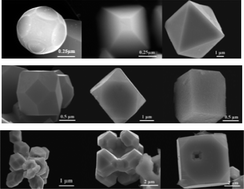TiC particles with various morphologies from octahedron to cube were synthesized and investigated by Field emission scanning electron microscopy (FESEM) in three-dimensional space. The morphological evolution of TiC grain and its growth mechanism were also discussed. TiC particles prefer an octahedral morphology (equilibrium shape) enclosed by eight {111} facets with minimized total surface free energy in Al–Ti–C alloy, while they tend to form a cube enclosed by six {100} facets under the influence of Ni in Al–Ni–Ti–C alloy. Due to the strong interaction between Ni–3d and C–2p orbitals, Ni atoms in the melt selectively absorb on {100} faces of the growing TiC crystal rather than on the polar {111} faces and reduce the specific surface energy of {100}. According to Wuff's theorem, the growth rate of {100} is lowered correspondingly, while the relative growth rate of {111} is accelerated. Thus, the higher growth rate along <111> direction will lead to the shrinkage of {111} faces gradually, while six {100} faces are reserved to form a TiC cube because of their lower growth rates. Furthermore, a similar morphology evolution to TiC crystals can also be found in Fe- and Co-containing melts. It is revealed that the crystal growth of TiC follows the same model under the effect of group VIII elements (Fe, Co and Ni).

